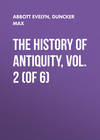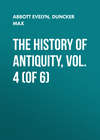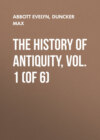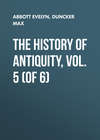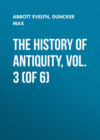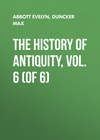Buch lesen: «The History of Antiquity, Vol. 2 (of 6)»
CHAPTER I
THE STORY OF NINUS AND SEMIRAMIS
About the middle course of the Tigris, where the mountain wall of the Armenian plateau steeply descends to the south, there is a broad stretch of hilly country. To the west it is traversed by a few water-courses only, which spring out of the mountains of Sindyar, and unite with the Tigris; from the east the affluents are far more abundant. On the southern shore of the lake of Urumiah the edge of the plateau of Iran abuts on the Armenian table-land, and then, stretching to the south-east, it bounds the river valley of the Tigris toward the east. From its vast, successive ranges, the Zagrus of the Greeks, flow the Lycus and Caprus (the Greater and the Lesser Zab), the Adhim and the Diala. The water, which these rivers convey to the land between the Zagrus and the Tigris, together with the elevation of the soil, softens the heat and allows olive trees and vines to flourish in the cool air on the hills, sesame and corn in the valleys between groups of palms and fruit-trees. The backs of the heights which rise to the east are covered by forests of oaks and nut trees. Toward the south the ground gradually sinks – on the west immediately under the mountains of Sindyar, on the east below the Lesser Zab – toward the course of the Adhim into level plains, where the soil is little inferior in fertility to the land of Babylonia. The land between the Tigris and the Greater Zab is known to Strabo and Arrian as Aturia.1 The districts between the Greater and Lesser Zab are called Arbelitis and Adiabene by western writers.2 The region bounded by the Lesser Zab and the Adhim or the Diala is called Sittacene, and the land lying on the mountains rising further toward the east is Chalonitis. The latter we shall without doubt have to regard as the Holwan3 of later times.
According to the accounts of the Greeks, it was in these districts that the first kingdom rose which made conquests and extended its power beyond the borders of its native country. In the old time – such is the story – kings ruled in Asia, whose names were not mentioned, as they had not performed any striking exploits. The first of whom any memorial is retained, and who performed great deeds, was Ninus, the king of the Assyrians. Warlike and ambitious by nature, he armed the most vigorous of his young men, and accustomed them by long and various exercises to all the toils and dangers of war. After collecting a splendid army, he combined with Ariæus, the prince of the Arabs, and marched with numerous troops against the neighbouring Babylonians. The city of Babylon was not built at that time, but there were other magnificent cities in the land. The Babylonians were an unwarlike people, and he subdued them with little trouble, took their king prisoner, slew him with his children, and imposed a yearly tribute on the Babylonians. Then with a still greater force he invaded Armenia and destroyed several cities. Barzanes, the king of Armenia, perceived that he was not in a position to resist. He repaired with costly presents to Ninus and undertook to be his vassal. With great magnanimity Ninus permitted him to retain the throne of Armenia; but he was to provide a contingent in war and contribute to the support of the army. Strengthened by these means, Ninus turned his course to Media. Pharnus, king of Media, came out to meet him with a strong force, but he was nevertheless defeated, and crucified with his wife and seven children, and Ninus placed one of his own trusty men as viceroy over Media. These successes raised in Ninus the desire to subjugate all Asia as far as the Nile and the Tanais. He conquered, as Ctesias narrates, Egypt, Phœnicia, Cœle Syria, Cilicia, Lycia and Caria, Lydia, Mysia, Phrygia, Bithynia, and Cappadocia, and reduced the nations on the Pontus as far as the Tanais. Then he made himself master of the land of the Cadusians and Tapyrians, of the Hyrcanians, Drangians, Derbiccians, Carmanians, Chorasmians, Barcians, and Parthians. Beside these, he overcame Persia, and Susiana, and Caspiana, and many other small nations. But in spite of many efforts he failed to obtain any success against the Bactrians, because the entrance to their land was difficult and the number of their men of war was great. So he deferred the war against the Bactrians to another opportunity, and led his army back, after subjugating in 17 years all the nations of Asia, with the exception of the Indians and Bactrians. The king of the Arabians he dismissed to his home with costly presents and splendid booty; he began himself to build a city which should not only be greater than any other then in existence, but should be such that no city in the future could ever surpass it. This city he founded on the bank of the Tigris,4 in the form of an oblong, and surrounded it with strong fortifications. The two longer sides measured 150 stades each, the two shorter sides 90 stades each, so that the whole circuit was 480 stades. The walls reached a height of 100 feet, and were so thick that there was room in the gangway for three chariots to pass each other. These walls were surmounted by 1500 towers, each of the height of 200 feet. As to the inhabitants of the city, the greater number and those of the most importance were Assyrians, but from the other nations also any who chose could fix his dwelling here, and Ninus allotted to the settlers large portions of the surrounding territory, and called the city Ninus, after his own name.
When the city was built Ninus resolved to march against the Bactrians. He knew the number and bravery of the Bactrians, and how difficult their land was to approach, and therefore he collected the armies of all the subject nations, to the number of 1,700,000 foot soldiers, 210,000 cavalry, and towards 10,600 chariots of war. The narrowness of the passes which protect the entrance to Bactria compelled Ninus to divide his army. Oxyartes, who at that time was king of the Bactrians, had collected the whole male population of his country, about 400,000 men, and met the enemy at the passes. One part of the Assyrian army he allowed to enter unmolested; when a sufficient number seemed to have reached the plains he attacked them and drove them back to the nearest mountains; about 100,000 Assyrians were slain. But when the whole force had penetrated into the land, the Bactrians were overcome by superior numbers and scattered each to his own city. The rest of the cities were captured by Ninus with little trouble, but Bactra, the chief city, where the palace of the king lay, he could not reduce, for it was large and well-provisioned, and the fortress was very strong.
When the siege became protracted, Onnes, the first among the counsellors of the king and viceroy of Syria, who accompanied the king on this campaign, sent for his wife Semiramis to the camp. Once when he was inspecting the flocks of the king in Syria, he had seen at the dwelling of Simmas, the keeper of these flocks, a beautiful maiden, and he was so overcome with love for her that he sought and obtained her as a wife from Simmas. She was the foster-child of Simmas. In a rocky place in the desert his shepherds had found the maiden about a year old, fed by doves with milk and cheese; as Simmas was childless he had taken the foundling as his child, and given her the name of Semiramis Onnes took her to the city of Ninus. She bore him two sons, Hyapates and Hydaspes, and as she had everything which beauty requires, she made her husband her slave; he did nothing without her advice, and everything succeeded admirably. She also possessed intelligence and daring, and every other gift likely to advance her. When requested by Onnes to come to the camp, she seized the opportunity to display her power. She put on such clothing that it could not be ascertained whether she was a man or a woman, and this succeeded so well that at a later time the Medes, and after them the Persians also, wore the robe of Semiramis. When she arrived in the camp she perceived that the attack was directed only against the parts of the city lying in the plain, not against the high part and the strong fortifications of the citadel, and she also perceived that this direction of the attack induced the Bactrians to be careless in watching the citadel. She collected all those in the army who were accustomed to climbing, and with this troop she ascended the citadel from a deep ravine, captured a part of it, and gave the signal to the army which was assaulting the walls in the plain. The Bactrians lost their courage when they saw their citadel occupied, and the city was taken. Ninus admired the courage of the woman, honoured her with costly presents, and was soon enchained by her beauty; but his attempts to persuade Onnes to give up Semiramis to him were in vain; in vain he offered to recompense him by the gift of his own daughter Sosana in marriage. At length Ninus threatened to put out his eyes if he did not obey his commands. The terror of this threat and the violence of his own love drove Onnes out of his mind. He hung himself. Thus Semiramis came to the throne of Assyria. When Ninus had taken possession of the great treasures of gold and silver which were in Bactra, and had arranged everything there, he led his army back. At Ninus Semiramis bore him a son, Ninyas, and at his death, when he had reigned 52 years, Ninus bequeathed to her the sovereign power. She buried his corpse in the royal palace, and caused a huge mound to be raised over the grave, 6000 feet in the circuit and 5400 feet high, which towered over the city of Ninus like a lofty citadel, and could be seen far through the plain in which Ninus lay.
As Semiramis was ambitious, and desired to surpass the fame of Ninus, she built the great city of Babylon, with mighty walls and towers, the two royal citadels, the bridge over the Euphrates, and the temple of Belus, and caused a great lake to be excavated to draw off the water of the Euphrates. Other cities also she founded on the Euphrates and the Tigris, and caused depôts to be made for those who brought merchandise from Media, Paraetacene, and the bordering countries. After completing these works she marched with a great army to Media and planted the garden near Mount Bagistanon. The steep and lofty face of this mountain, more than 10,000 feet in height, she caused to be smoothed, and on it was cut her picture surrounded by 100 guards; and an inscription was engraved in Syrian letters, saying that Semiramis had caused the pack-saddles of her beasts of burden to be piled on each other, and on these had ascended to the summit of the mountain. Afterwards she made another large garden near the city of Chauon, in Media,5 and on a rock in the middle of it she erected rich and costly buildings, from which she surveyed the blooming garden and the army encamped in the plain. Here she remained for a long time, and gave herself up to every kind of pleasure. She was unwilling to contract another marriage from fear of losing the sovereign power, but she lived with any of her warriors who were distinguished for their beauty. All who had enjoyed her favours she secretly put to death. After this retirement she turned her course to Egbatana, caused a path to be cut through the rocks of Mount Zagrus, and a short and convenient road to be made across them, in order to leave behind an imperishable memorial of her reign. In Egbatana she erected a splendid palace, and in order to provide the city with water she caused a tunnel to be made through the lofty mountain Orontes at its base, which conveyed the water of a lake lying on the other side of the heights into the city. After this she marched through Persia and all the countries of Asia which were subject to her, and caused the mountains to be cut through and straight and level roads to be built everywhere, while in the plains she at one place raised great mounds over her dead generals, and in another built cities on hills; and wherever the army was encamped eminences were raised for her tent so that she might overlook the whole. Of these works many are still remaining in Asia and bear the name of Semiramis. Then she subjugated Egypt,6 a great part of Libya, and nearly the whole of Ethiopia, and finally returned to Bactra.
A long period of peace ensued, till she resolved to subjugate the Indians on hearing that they were the most numerous of all nations, and possessed the largest and most beautiful country in the world. For two years preparations were made throughout her whole kingdom; in the third year she collected in Bactria 3,000,000 foot soldiers, 500,000 horsemen, and 100,000 chariots. Beside these, 100,000 camels were covered with the sewn skins of black oxen, and each was mounted by one warrior; these animals were intended to pass for elephants with the Indians. For crossing the Indus 2000 ships were built, then taken to pieces again, and the various parts packed on camels. Stabrobates, the king of the Indians, awaited the Assyrians on the bank of the Indus. He also had prepared for the war with all his power, and gathered together even a larger force from the whole of India. When Semiramis approached he sent messengers to meet her with the complaint that she was making war upon him though he had done her no wrong; and in his letter he reproached her licentious life, and calling the gods to witness, threatened to crucify her if victorious. Semiramis read the letter, laughed, and said that the Indians would find out her virtue by her actions. The fleet of the Indians lay ready for battle on the Indus. Semiramis caused her ships to be put together, manned them with her bravest warriors, and, after a long and stubborn contest, the victory fell to her share. A thousand ships of the Indians were sunk and many prisoners taken. Then she also took the islands and cities on the river, and out of these she collected more than 100,000 prisoners. But the king of the Indians, pretending flight, led his army back from the Indus; in reality he wished to induce the enemy to cross the Indus. As matters succeeded according to her wishes, Semiramis caused a large and broad bridge to be thrown skilfully over the Indus, and on this her whole army passed over. Leaving 60,000 men to protect the bridge, she pursued the Indians with the rest of her army, and sent on in front the camels clothed as elephants. At first the Indians did not understand whence Semiramis could have procured so many elephants and were alarmed. But the deception could not last. Soldiers of Semiramis, who were found careless on the watch, deserted to the enemy to escape punishment, and betrayed the secret. Stabrobates proclaimed it at once to his whole army, caused a halt to be made, and offered battle to the Assyrians. When the armies approached each other the king of the Indians ordered his horsemen and chariots to make the attack. Semiramis sent against them her pretended elephants. When the cavalry of the Indians came up their horses started back at the strange smell, part of them dislodged their riders, others refused to obey the rein. Taking advantage of this moment, Semiramis, herself on horseback, pressed forward with a chosen band of men upon the Indians, and turned them to flight. Stabrobates was still unshaken; he led out his elephants, and behind them his infantry. Himself on the right wing, mounted on the best elephant, he chanced to come opposite Semiramis. He made a resolute attack upon the queen, and was followed by the rest of the elephants. The soldiers of Semiramis resisted only a short time. The elephants caused an immense slaughter; the Assyrians left their ranks, they fled, and the king pressed forward against Semiramis; his arrow wounded her arm, and as she turned away his javelin struck her on the back. She hastened away, while her people were crushed and trodden down by their own numbers; and at last, as the Indians pressed upon them, were forced from the bridge into the river. As soon as Semiramis saw the greater part of her army on the nearer bank, she caused the cables to be cut which held the bridge; the force of the stream tore the beams asunder, and many Assyrians who were on the bridge were plunged in the river. The other Assyrians were now in safety, the wounds of Semiramis were not dangerous, and the king of the Indians was warned by signs from heaven and their interpretation by the seers not to cross the river. After exchanging prisoners Semiramis returned to Bactra. She had lost two-thirds of her army.
Some time afterwards she was attacked by a conspiracy, which her own son Ninyas set on foot against her by means of an eunuch. Then she remembered a prophecy given to her in the temple of Zeus Ammon during the campaign in Libya; that when her son Ninyas conspired against her she would disappear from the sight of men, and the honours of an immortal would be paid to her by some nations of Asia. Hence she cherished no resentment against Ninyas, but, on the contrary, transferred to him the kingdom, ordered her viceroys to obey him, and soon after put herself to death, as though, according to the oracle, she had raised herself to the gods. Some relate that she was changed into a dove, and flew out of the palace with a flock of doves. Hence it is that the Assyrians regard Semiramis as an immortal, and the dove as divine. She was 62 years old, and had reigned 42 years.
The preceding narrative, which is from Diodorus, is borrowed in essentials from the Persian history of Ctesias, who lived for some time at the Persian Court in the first two decades of the reign of Artaxerxes Mnemon (405-361 B.C.). On the end of Semiramis the account of Ctesias contained more details than the account of Diodorus. This is made clear by some fragments from Ctesias preserved by other writers. In Nicolaus of Damascus we are told that after the Indian war Semiramis marched through the land of the Medes. Here she visited a very lofty and precipitous mountain, which could only be ascended on one side. On this she at once caused an abode to be built from which to survey her army.
While encamped here, Satibaras the eunuch told the sons of Onnes, Hyapates and Hydaspes, that Ninyas would put them to death if he ascended the throne; they must anticipate him by removing their mother and Ninyas out of the way, and possessing themselves of the sovereign power. Moreover, it was to their great dishonour to be spectators of the licentiousness of their mother, who, even at her years, daily desired every youth that came in her way. The matter, he said, was easy of accomplishment; when he summoned them to the queen (he was entrusted with this business) they could come to the summit of the mountain and throw their mother down from it. But it happened that behind the altar, near which they held this conversation, a Mede was lying, who overheard them. He wrote down everything on a skin and sent it to Semiramis. When she had read it she caused the sons of Onnes to be summoned, and gave strict orders that they should come in arms. Delighted that the deity favoured the undertaking, Satibaras fetched the young men. When they appeared Semiramis bade the eunuch step aside, and then she spoke to them: "You worthless sons of an honest and brave father have allowed yourselves to be persuaded by a worthless slave to throw down from this height your mother, who holds her empire from the gods, in order to obtain glory among men, and to rule after the murder of your mother and your brother Ninyas. Then she spoke to the Assyrians."7 Here the fragment of Nicolaus breaks off. From the fragments of Cephalion we may gather that the sons of Onnes were put to death by Semiramis. Yet Cephalion gave a different account of the death of Semiramis from Ctesias; according to him Ninyas slew her.8 In Ctesias, as is clear from the account of Diodorus and other remains of Ctesias, nothing was spoken of beyond the conspiracy which Ninyas prepared against her.9
After the death of Semiramis, so Diodorus continues his narrative, Ninyas ruled in peace, for he by no means emulated his mother's military ambition and delight in danger. He remained always in the palace, was seen by no one but his concubines and eunuchs, took upon himself no care or trouble, thought only of pleasure and pastime, considered it the object of sovereign power to give himself up undisturbed to all sorts of enjoyment. His seclusion served to hide his excesses in obscurity; he seemed like an invisible God, whom no one ventured to offend even in word. In order to preserve his kingdom he put leaders over the army, viceroys, judges, and magistrates over every nation, and arranged everything as seemed most useful to himself. To keep his subjects in fear he caused each nation to provide a certain number of soldiers every year, and these were quartered together in a camp outside the city, and placed under the command of men most devoted to himself. At the end of the year they were dismissed and replaced by others to the same number. Hence his subjects always saw a great force in the camp ready to punish disobedience or defection. In the same way his descendants also reigned for 30 generations, till the empire passed to the Medes.10 Slightly differing from this account, Nicolaus tells us that Sardanapalus – to whom in the order of succession the kingdom of Ninus and Semiramis finally descended – neither carried arms nor went out to the hunting-field, like the kings in old times, but always remained in his palace. Yet even in his time the old arrangements were kept and the satraps of the subject nations gathered with the fixed contingent at the gate of the king.11
From what source is the narrative of Ninus and Semiramis derived? what title to credibility can be allowed it? Herodotus states that the dominion of the Assyrians in Asia was the oldest; their supremacy was followed by that of the Medes, and the supremacy of the Medes was followed by the kingdom of the Achæmenids. Herodotus too is acquainted with the name of Semiramis; he represents her as ruling over Babylon, and building wonderful dykes in the level land, which the river had previously turned into a lake.12 Strabo tells of the citadels, cities, mountain-roads, aqueducts, bridges, and canals which Semiramis constructed through all Asia, and to Semiramis Lucian traces back the old temples of Syria.13 We may assume in explanation that the tradition of Hither Asia has ascribed to the first king and queen of Assyria the construction of the ancient road over the Zagrus, of old dykes and aqueducts in the land of the Euphrates and Tigris, the building, not of Nineveh only, but also of Babylon, the erection of the great monuments of forgotten kings of Babylon, – as a fact, Assyrian kings built in Babylon also in the seventh century. We may find it conceivable that this tradition has gathered together and carried back to the time of the foundation all that memory retained of the acts of Assyrian rulers, the campaigns of conquest of a long series of warlike and mighty sovereigns, the sum total of the exploits to which Assyria owed her supremacy. Yet against such an origin of this narrative doubts arise not easy to be removed. It is true that when this tradition explains the mode of life and the clothing of the kings of Asia, and the clothing of the Medes and Persians, from the example of Semiramis, who wore in the camp a robe, half male and half female (p. 6); when this tradition derives the inaccessibility of the kings of Asia and their seclusion in the palace from the fact that Ninyas wished to hide his excesses, and appear to his subjects as a higher being, – traits of this kind can be set aside as additions of the Greeks. To the Babylonians and Assyrians, the Medes and Persians, the life and clothing of their rulers could not appear contemptible or remarkable, nor their own clothing half effeminate, though the Greeks might very well search for an explanation of customs so different from their own, and find them in the example and command of Semiramis, and the example of Ninyas. And if in Herodotus the empire of the Assyrians over Asia appears as a hegemony of confederates,14 this idea is obviously borrowed from Greek models. The opposite statement of the division of the Assyrian kingdom into satrapies, the yearly change of the contingents of troops, comes from Ctesias, who transferred the arrangements of the Persian kingdom, with which he was acquainted, to their predecessors, the kingdom of the Assyrians, or found this transference made in his authorities, Persian or Mede, and copied it.
Yet, after making as much allowance as we can for the amalgamating influence of native tradition, after going as far as we can in setting apart what may be due to the Greeks, how could such an accurate narrative, so well acquainted with every detail of the siege of Bactra, and the battle on the Indus, have been preserved for many centuries in the tradition of Hither Asia, retained even after the overthrow of Assyria, and down to the date when curious Greeks, 200 years after the fall of Nineveh, reached the Euphrates and Tigris? We possess a positive proof that about this time, in the very place to which this tradition must have clung most tenaciously, within the circuit of the old Assyrian country, no remembrance of that mighty past was in existence. When, in the year 401 B.C., Xenophon with his 10,000 marched past the ruins of the ancient cities of the Assyrian kingdom, the ruins of Asshur, Chalah, and Nineveh, before Ctesias wrote, he was merely told that these were cities of the Medes which could not be taken; into one of them the queen of the Medes had fled before the Persian king, and the Persians, with the help of heaven, took and destroyed it when they gained the dominion over Media.15 From the Assyrians, therefore, Herodotus and Ctesias could not have obtained the information given in their statements about Ninus and Semiramis, nor could their knowledge have come from the Babylonians. The tradition of Babylonia would never have attributed the mighty buildings of that city and land to the queen of another nation, to which Babylon had succumbed. Hence the account of the Greeks about Assyria and her rulers could only come from the Medes and Persians. But our narrative ascribes to Semiramis even the great buildings of the Median rulers, the erection of the royal citadel of Egbatana, the residence of the Median kings; the parks and rock sculptures of Media, even the rock figure on Mount Bagistanon (p. 7). This sculpture in the valley of the Choaspes on the rock-wall of Bagistan (Behistun) is in existence. The wall is not 10,000 but only 1500 feet high. It is not Semiramis who is pourtrayed in those sculptures, but Darius, the king of Persia, and before him are the leaders of the rebellious provinces. It was the proudest monument of victory in all the history of Persia. Would a Persian have shown this to a Greek as a monument of Semiramis? It would rather be a Mede, who would wish to hide from the Greeks that Media was among the provinces a second time conquered and brought to subjection.
The difficulty of ascertaining the sources of our narrative is still further increased in no inconsiderable degree by the fact that the books of Ctesias are lost, and that Diodorus has not drawn immediately from them, but from a reproduction of Ctesias' account of Assyria. Yet the express references to the statements of Ctesias which Diodorus found in his authority, as well as fragments relating to the subject which have been elsewhere preserved, allow us to fix with tolerable accuracy what belongs to Ctesias in this narrative, and what Clitarchus, the renewer of his work, whom Diodorus had before him, has added.16 It is Ctesias who enumerates the nations which Ninus subdued (p. 3). With him Semiramis was the daughter of a Syrian and Derceto, who throws herself into the lake of Ascalon, and is then worshipped as a goddess there.17 To Ctesias belongs the nourishment of the child Semiramis by the doves of the goddess, her rise from the shepherd's hut to the throne of Assyria. He represents her as raising the mountain or the tomb of Ninus; he ascribes to her the building of Babylon, its mighty walls and royal citadels, the aqueducts, and the great temple of Bel. He represented her as marching to the Indus18 and afterwards towards Media; as making gardens there and building the road over the Zagrus. He represented her as raising the mounds over the graves of her lovers;19 he told of her sensuality, of the designs of her sons by the first marriage, and the plot of Ninyas; he recounted her end, which was as marvellous as her birth and her youth: she flew out of the palace up to heaven with a flock of doves. If the conquest of Egypt by Semiramis also belongs to Ctesias,20 the march through Libya, and the oracle given to her in the oasis of Ammon, together with the version of her death, which rests on this oracle (she caused herself to disappear, i. e. put herself to death, in order to share in divine honours), belong to Clitarchus.
If, therefore, we may regard it as an established fact that our narrative has not arisen out of Assyrian or Babylonian tradition, that the views and additions of Greek origin introduced into it leave the centre untouched; if we have succeeded in discovering, to a tolerably satisfactory degree, the outlines of the narrative of Ctesias, the main question still remains to be answered: from what sources is this narrative to be derived? In the first attempt to criticise this account we find ourselves astonished by the certainty of the statements, the minute and, in part, extremely vivid descriptions of persons and incidents. Not only the great prince who founded the power of Assyria, and the queen whose beauty and courage enchanted him, are known to Ctesias in their words and actions. He can mention by name the man who nurtured Semiramis as a girl, and her first husband. He knows the names of the princes of the Arabs, Medes, Bactrians, and Indians with whom Ninus and Semiramis had to do. The number of the forces set in motion against Bactria and India are given accurately according to the weapon used. The arrangements of the battle beyond the Indus, the progress of the fight, the wounds carried away by Semiramis, the exchange of prisoners, are related with the fidelity of an eye-witness. Weight is obviously laid on the fact that after Semiramis had conquered and traversed Egypt and Ethiopia, after her unbroken success, the last great campaign against the Indians fails because she attacked them without receiving any previous injury. The message which Stabrobates sends to her, the letter which he writes, the reproaches he makes upon her life, the minute details which Ctesias gives of the relation of Onnes to Semiramis, of the conspiracy of the sons by this marriage, who felt themselves dishonoured by the conduct of their now aged mother, of the letter of the Mede, whose fidelity discovered the plot to her, of the speeches which Semiramis made on this occasion, carry us back to a description at once vivid and picturesque. If we take these pictures together with the account of Ctesias about the decline of the Assyrian kingdom, in which also very characteristic details appear, if we consider the style and the whole tone of these accounts of the beginning and the end of the Assyrian kingdom, we cannot avoid the conclusion that Ctesias has either invented the whole narrative or followed a poetic source.
